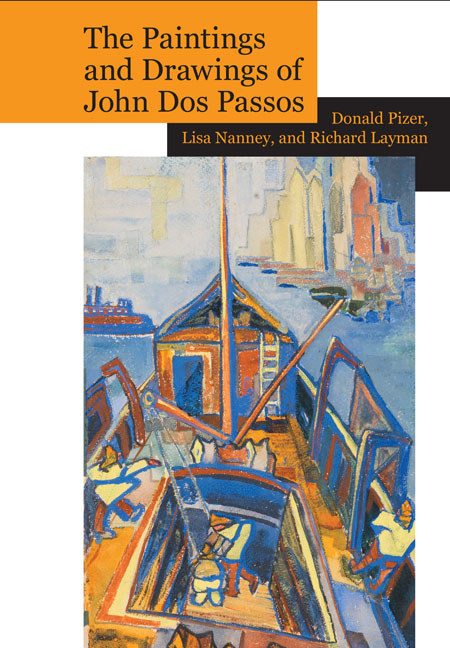Book contents
- Frontmatter
- Contents
- Preface
- Acknowledgments
- The Paintings and Drawings of John Dos Passos: A Collection and Study
- Introduction
- Paintings and Drawings Included in this Volume: A Descriptive List
- Preface to Section 1: Early Work 1918–20
- Preface to Section 2: The Middle East and Morocco 1921–22, 1926
- Preface to Section 3: Paris 1921–25
- Preface to Section 4: New York 1920–24
- Preface to Section 5: New York: Nudes 1920–23
- Preface to Section 6: Theater Designs 1925–28
- Preface to Section 7: Mexico 1926–32
- Preface to Section 8: Later Work 1930–70
- Preface to Section 9: Portraits
- Preface to Section 10: Sea Fronts and Harbors
- Preface to Section 11: Still Lifes
- Preface to Section 12: Studies in Motion
- Preface to Section 13: Abstractions and Other Experimental Modes
- Words and Images: The Visual Art of John Dos Passos
- The Artwork of John Dos Passos
- Notes
- Works Cited
- Index
- Plate section
Preface to Section 4: New York 1920–24
from The Paintings and Drawings of John Dos Passos: A Collection and Study
- Frontmatter
- Contents
- Preface
- Acknowledgments
- The Paintings and Drawings of John Dos Passos: A Collection and Study
- Introduction
- Paintings and Drawings Included in this Volume: A Descriptive List
- Preface to Section 1: Early Work 1918–20
- Preface to Section 2: The Middle East and Morocco 1921–22, 1926
- Preface to Section 3: Paris 1921–25
- Preface to Section 4: New York 1920–24
- Preface to Section 5: New York: Nudes 1920–23
- Preface to Section 6: Theater Designs 1925–28
- Preface to Section 7: Mexico 1926–32
- Preface to Section 8: Later Work 1930–70
- Preface to Section 9: Portraits
- Preface to Section 10: Sea Fronts and Harbors
- Preface to Section 11: Still Lifes
- Preface to Section 12: Studies in Motion
- Preface to Section 13: Abstractions and Other Experimental Modes
- Words and Images: The Visual Art of John Dos Passos
- The Artwork of John Dos Passos
- Notes
- Works Cited
- Index
- Plate section
Summary
After his discharge from service in the Medical Corps in Italy and France, followed by some months in Spain, Dos Passos returned to New York in 1920 and made it his base between further journeys through the late 1920s. He recalled in The Best Times that he had returned from war and the Near East uncertain of whether he wished most to write or paint (130). But wanting “to get a lot of things off [his] chest … one book led to another” during the early 1920s and though he resisted “setting up as an author” and “let[ting] anybody classify” him (130–31), by 1925 he had published volumes of poetry and essays, plays, and four novels, including his groundbreaking modernist work about New York, Manhattan Transfer.
The city, he said “was a continent in itself.” He wrote his friend Arthur McComb that life was constant activity: “I paint and scribble and dine in Italian restaurants and talk to bums on park benches, and the days fly by like flocks of ducks—whirr and they're gone.” He explored the city with friends who also “scribbled,” literary friends such as E. E. Cummings, Scott and Zelda Fitzgerald, Edmund Wilson, Dawn Powell, and John Howard Lawson. But, he recalled, he “lived as much for the sights [he] saw as for the sound of words,” and he spent time in particular with a friend who was a painter, Adelaide Lawson. With her he studied sketching and undertook serious painting at a time when revolutions in modern art pervaded the city's galleries and museums. Through her he became involved in New York artists’ groups and began to show his work—at the Salons of America several times throughout the 1920s and at the Whitney Studio Club in 1923.
The watercolors and gouaches Dos Passos painted in the early 1920s convey the “whirr” of the city, record his fascination with the dynamics of that motion, and reflect his experimentation with visual modernism. One of the apartments he rented periodically during the 1920s had “a marvelous view of the Brooklyn waterfront” in Columbia Heights (164). Figures 20a, 21, and 22 all evoke the perpetual activity in such a panoramic perspective across water, each trying a distinctive method of doing so.
- Type
- Chapter
- Information
- Publisher: Liverpool University PressPrint publication year: 2016



